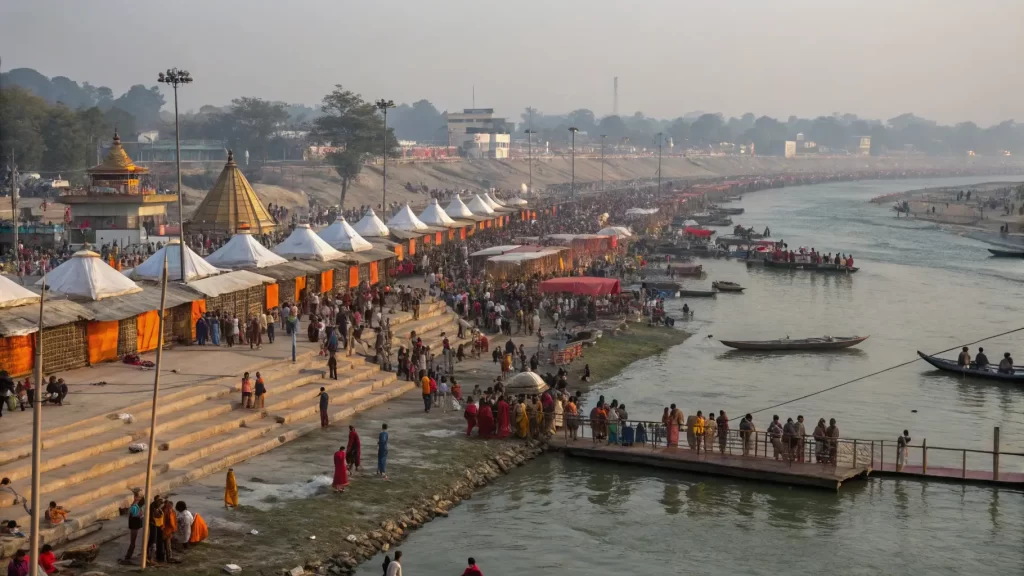India’s spiritual tapestry is woven from threads of timeless myth, unwavering devotion, and cosmic alignments. Every twelve years or so, one shimmering strand draws global attention to the banks of the Triveni Sangam in Prayagraj—the Maha Kumbh Mela. This immersive festival, recognized as an Intangible Cultural Heritage by UNESCO, transcends mere ritual, merging religious fervor, cultural unity, and astrological precision into a colossal event that showcases India’s capabilities in managing massive crowds and maintaining a sense of community and shared heritage.
This year’s Maha Kumbh Mela is especially noteworthy. According to many Indian astrological and scholarly sources, 2025 will witness a rare planetary configuration—governed by Jupiter (Brihaspati), the Sun (Surya), and the Moon (Chandra)—that allegedly occurs once every 144 years. Such a cosmic rarity amplifies the festival’s spiritual momentum, making the forthcoming Kumbh Mela a must-attend spectacle of faith, tradition, and cosmic wonder.
Introduction
The Kumbh Mela is a significant Hindu pilgrimage festival celebrated approximately every 6, 12, and 144 years. It is observed at four major pilgrimage sites: Prayagraj, Haridwar, Nashik-Trimbak, and Ujjain. The festival is a celebration of community commerce, education, and entertainment, marked by a ritual dip in the waters, which is believed to cleanse the pilgrims of their sins. The Kumbh Mela is one of the largest peaceful gatherings in the world, attracting over 200 million Hindus.
Key Facts at a Glance
Below is a concise, tabular summary of essential information for the Maha Kumbh Mela 2025. Please note: Some data (especially specific Snan dates and attendance numbers) may be updated as official announcements are released.
| Key Parameter | Details |
|---|---|
| Event Name | Maha Kumbh Mela 2025 (2025 प्रयागराज महाकुंभ मेला) |
| Location | Prayagraj (formerly- Allahabad), Uttar Pradesh, India |
| Confluence (Sangam) | Ganga, Yamuna, and the mythological Saraswati |
| Approximate Date Range | 13 January – 26 February 2025 (Exact dates announced by the Government of Uttar Pradesh and religious councils closer to the festival) |
| Frequency | Occurs every 12 years at Prayagraj (the full Kumbh cycle among the four sites repeats every 12 years each) |
| Special Alignment | Astrologers note a rare constellation configuration occurring once in 144 years, involving Jupiter, Surya, and Chandra |
| Projected Attendance | Estimated 150 million+ visitors over the entire duration (Subject to official updates) |
| Previous Maha Kumbh | 2013 (Prayagraj), where attendance reportedly surpassed 100 million |
| Next Maha Kumbh | 2037 (tentative) at Prayagraj, depending on the 12-year cycle |
| UNESCO Status | Recognized as part of the “Intangible Cultural Heritage of Humanity” |
| Main Ritual | Holy dip (shahi snan) at the Triveni Sangam, believed to cleanse sins and bestow spiritual merit |
| Major Activities | Processions of Naga Sadhus, satsangs (spiritual discourses), yagnas (fire rituals), community service (seva), and cultural events |
| Local Impact | Temporary mega-settlement with tents, sanitation, medical camps, security, and a significant economic boost for the region |
| Live Updates | Click here (Link for official updates and announcements) |
Ancient Origins and Mythical Foundations
Many centuries ago—so long that the exact commencement date remains cloaked in the mists of time—people assembled at these intervals to honor the mythological episode of Samudra Manthan (the churning of the cosmic ocean). According to Hindu lore, Devas (gods) and Asuras (demons) contended for a sacred pitcher of amrita (the nectar of immortality). During the ensuing struggle, a few drops spilled onto four places on Earth, including Prayagraj. The festival derives its name from the Sanskrit term Kumbh (pot), commemorating this divine occurrence.
Over the ages, pilgrims have flocked to these holy sites for punya (spiritual merit) by bathing at the confluence of the Ganga, Yamuna, and the ethereal Saraswati. This tradition thrives unbroken—rooted in devotion, mythology, and profound astrological significance.
Why the Kumbh Mela Is Celebrated

Spiritual Cleansing and Moksha
Devotees believe that taking a holy dip in the Triveni Sangam samagam can purify their souls of past sins (paap) and guide them toward moksha (spiritual liberation). The act is not merely ritualistic but also a moment of deep introspection and transformation.
Cosmic Choreography
The timing of the Kumbh Mela at each of its four sites—Prayagraj, Haridwar, Nashik, and Ujjain—depends on the zodiac sign of Jupiter (Brihaspati), in combination with the positions of Surya and Chandra. For 2025, these celestial bodies align in a way seldom observed—reportedly once every 144 years—imparting heightened spiritual energy to the gathering.
Cultural and Communal Unity
The Kumbh Mela fosters a spirit of oneness, breaking barriers of caste, creed, and nationality. Devotees from modest hamlets to metropolitan hubs, along with overseas visitors, unite to share langar (community meals), cultural wisdom, and collective worship.
Why the Year 2025 Is So Special (2025 प्रयागराज महाकुंभ मेला)
Though India has celebrated countless Kumbh Melas, 2025 stands out due to its distinctive planetary configuration in the context of Hinduism. Based on astronomical calculations, the 2025 Kumbh Mela is particularly noteworthy, as it features a rare constellation alignment that occurs only once in 144 years. The location of each Kumbh Mela is determined by the celestial positions of Jupiter, the Sun (Surya), and the Moon (Chandra).
According to numerous Indian astrology sources, this cosmic convergence significantly magnifies the festival’s sacred aura. For those devout at heart, it’s an extraordinary moment to invite divine blessings; for the inquisitive observer, it’s an immersive journey into one of humankind’s most grandiose spiritual events.
Magnitude and Record-Breaking Gatherings
Unprecedented Congregation: The 2013 Maha Kumbh Mela at Prayagraj drew over 100 million pilgrims. Estimates suggest the 2025 Mela may surpass 150 million over its multi-week duration—though official numbers will be confirmed once the event concludes.
Temporary Megacity: During the festival, an immense settlement arises along the riverbanks of the Ganges, complete with makeshift roads, sanitation systems, security outposts, and an endless array of tents. This ephemeral hub thrums with activity day and night, hosting processions, satsangs, and cultural performances.
Global Spotlight: Travelers from every corner of the globe—yogis, photographers, researchers, spiritual seekers—descend upon Prayagraj, drawn by both the festival’s colossal scale and its promise of transformative insight.
Logistics and Preparation
The Kumbh Mela requires significant planning and infrastructure to accommodate the large number of pilgrims. The festival site is predominantly submerged during the monsoon months, making the task of construction and management even more challenging. The Indian government authorities, in co-operation with Seva volunteers, monks, and Indian companies, set up 11 sectors with 55 camp clusters, providing round-the-clock services. The festival site is strictly vegetarian, and many pilgrims practice partial or full vrata (day-long fasting). Celebratory feasts are held, where a vast number of people sit in rows and share a community meal – Mahaprasada – prepared by volunteers from charitable donations.
Safety and Security
The safety and security of the pilgrims are of utmost importance during the Kumbh Mela. About 40,000 police officers from the Uttar Pradesh Police and surveillance systems are deployed for the event. Security forces from the Uttar Pradesh Provincial Armed Constabulary (UP-PAC), National Disaster Response Force, and Central Armed Police Forces collaborate to ensure safety at the event.
A network of around 2,300 cameras provides round-the-clock monitoring, enhancing surveillance across the Mela area. Underwater drones capable of diving up to 100 m (330 ft) are used in recovery operations. The state government allocates ₹1.31 billion (US$15 million) for the fire department. The Uttar Pradesh Fire and Emergency Services Department is deploying 351 firefighting vehicles along with over 2,000 personnel across more than 50 fire stations and 20 fire posts.
Government Involvement
The government plays a significant role in the organization and management of the Kumbh Mela. The Prayagraj Mela Committee is responsible for setting up the festival site, providing amenities, and ensuring the safety and security of the pilgrims. The Uttar Pradesh State Government has appointed 500 dedicated Ganga Praharis to ensure the cleanliness of the river during the Maha Kumbh. The government also allocates a significant budget for the event, with the 2025 Maha Kumbh Mela having a budget of ₹63.82 billion (US$740 million). The government’s involvement helps to ensure the smooth conduct of the festival and provides a safe and secure environment for the pilgrims.
Spiritual and Societal Benefits
Holistic Well-Being
Beyond the sacred dip, participants engage in yagnas (fire rituals), kirtans (devotional singing), and meditative practices. These ancient customs aim to rejuvenate the mind, nourish the body, and uplift the soul.Community Service (Seva)
Numerous ashrams and humanitarian organizations set up free lodging, healthcare camps, and meals. This ethos of seva underscores the Indian tenet of Vasudhaiva Kutumbakam—the entire world is one family.Cultural Preservation
The Mela functions as a living repository of India’s intangible cultural expressions—folk music, drama, handicrafts, and philosophical discourses. It ensures the ongoing vitality and reinvigoration of these practices.Socio-Economic Impact
Local enterprises—hotels, artisans, eateries, and transport services—thrive as the influx of pilgrims and visitors stimulates robust commercial activity.
Additional Facts and Observations
UNESCO Acknowledgment:
Since 2017, Kumbh Mela has been part of UNESCO’s “Intangible Cultural Heritage of Humanity,” underscoring its universal cultural significance.Naga Sadhu Processions:
The most mesmerizing spectacle for many attendees is the procession of Naga Sadhus—ascetics clothed primarily in vibhuti (holy ash). With a spirited fervor, they lead the shahi snan (royal bath) and captivate onlookers with their fierce spiritual dedication.Complex Celestial Calculations:
Astrologers use meticulous formulas involving the positions of Jupiter (Brihaspati), Surya, and Chandra to designate auspicious snan (bathing) days. Each date carries a unique spiritual potency, drawing throngs of devotees to the riverside.Organizational Mastery:
Coordinating a festival of this magnitude requires months of planning and execution by government bodies, religious councils, and volunteers. From crowd control to pollution management and healthcare facilities, Mela’s organizational tapestry is a marvel in itself.
Keeping Up to Date
Given the dynamic nature of a gathering this large, official announcements and logistical details are often refined closer to the event. For the latest information on bathing dates, transit advisories, and additional guidelines, please refer to:
1. Government of Uttar Pradesh Tourism: upstdc.co.in
2. Official Maha Kumbh Portal- kumbh.gov.in
3. 2025 Maha Kumbh Mela Tour Packages: kumbh.gov.in/en/tourpackages
2025 Prayag Maha Kumbh Mela (2025 प्रयागराज महाकुंभ मेला) Live Streaming
Concluding Reflections
The Maha Kumbh Mela 2025 at Prayagraj transcends mere observance; it stands as a phenomenon of humanity united in devotion. It interlaces millennia-old mythology, astrological science, socio-economic advancement, and environmental mindfulness into a single grand celebration. Whether your interest is rooted in faith, cultural curiosity, or a fascination with rare cosmic events, the 2025 Maha Kumbh Mela promises a once-in-144-year rendezvous with the exalted.
Mark your calendar, ready your spirit, and prepare to be swept away in the swirl of devotion at the Triveni Sangam. Join sadhus, pilgrims, and global explorers as they converge upon Prayagraj to partake in an ancient tradition vibrantly harmonized with the cosmos.
For in-depth astrological articles, updated travel tips, and official announcements, stay connected with deluxeastrology.com. May this cosmic confluence enlighten and uplift all who participate.
References:
Disclaimer
The data and information presented here have been compiled from various publicly available online sources, government portals, and traditional belief systems. All attendance figures, date ranges, and statistics are estimates or projections that may vary. Exact festival dates and attendance counts will be confirmed by official government bodies and reliable news outlets closer to the event. Always consult reputable sources for the most current details.


